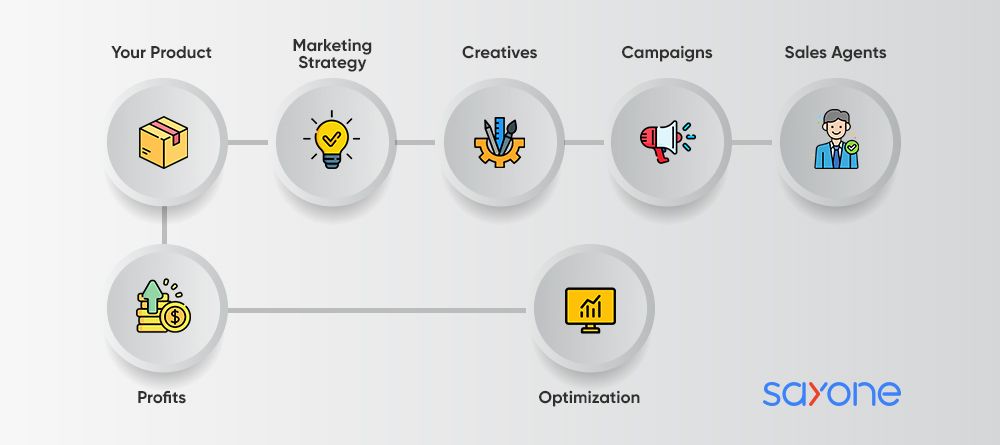
Subscribe to our Blog
We're committed to your privacy. SayOne uses the information you provide to us to contact you about our relevant content, products, and services. check out our privacy policy.

Akhil SundarSeptember 11, 20237 min read

Generating table of contents...
At their core, Microservices is a method of software design where applications are built as a collection of loosely coupled, independently deployable services. Each of these services typically caters to a single business capability. These services can be quickly developed, tested, and scaled by focusing on singular functions.
Eric Evans invented Domain-Driven Design (DDD), which is based on the fundamental concept of bounded context. It describes the line of a certain domain that a particular framework operates within. Each bounded context is in charge of a certain area inside the application's domain and has its own bounds. By keeping the model isolated and consistent inside a constrained environment, this separation lowers complexity and improves maintainability.
In the journey of building scalable and maintainable microservices, understanding the concept of 'Bounded Context' is pivotal. It acts as a guiding light, ensuring that microservices don't get entangled in confusing relationships or definitions. Think of it as the boundary within which specific terms, definitions, and operations have a clear meaning. As a firm seeking microservice development, grasping this ensures your projects don't end up with services stepping on each other's toes, leading to efficiency and clarity.
Choosing the right development partner can aid in effectively harnessing the power of microservices and implementing a clear, bounded context. This ensures your business capabilities are distinctly addressed, with minimal overlaps, fostering clarity and growth.
Microservices are increasingly being recognized for the agility and scalability they offer. For businesses that aim to stay competitive by tapping into microservices architecture, understanding the core principles behind them is crucial.
The term' Bounded Context' finds its roots in Domain-Driven Design (DDD). Eric Evans, the brain behind DDD, highlighted the necessity to set boundaries within which specific terms have explicit meanings. Just as words might have different meanings in different languages or cultures, software entities can assume different definitions in different contexts.
In Microservices, the Bounded Context ensures that each microservice has its own distinct Context where all terms and entities have a clear, unambiguous meaning. This autonomy avoids confusion and potential conflicts, ensuring each microservice performs its designated function without disruption.
For organizations scouting for a microservices development firm, understanding the role and importance of Bounded Context can provide a benchmark for quality. Opting for a firm that acknowledges and incorporates this principle can be the difference between a smooth-running system and one plagued with integration issues. The Bounded Context, therefore, not only provides clarity for developers but also sets the foundation for a system tailored to your unique business needs.
Checkout : Top 6 Microservices Trends to Take Note of in 2023
Microservices have revolutionized the way applications are designed and maintained. At the heart of this approach lies the concept of the 'bounded context,' which plays a pivotal role in ensuring that microservices effectively serve their intended purpose.
One of the primary concerns when designing microservices is ensuring that each service functions independently. The bounded Context helps in this aspect by defining clear boundaries. By understanding the specific Context in which a microservice operates, developers can prevent unwanted overlaps and ensure each microservice stays true to its defined role. This clarity not only aids in avoiding potential conflicts but also ensures that services remain decoupled, paving the way for more transparent and manageable systems.
Another vital aspect of the bounded Context is its role in maintaining modularity. Businesses can ensure that each microservice adheres to its bounded Context and that individual modules can be updated, replaced, or scaled without impacting the entire system. This level of autonomy is what attracts many businesses to microservices in the first place.
When each service is a self-contained unit, it makes the entire system more resilient and easier to manage.
In a microservices architecture, bounded contexts aid in controlling data consistency and isolation. Every bounded context has a database schema and data model that are tailored to meet its unique needs. By doing this, the requirement for a single, monolithic database is eliminated and data management complexity is decreased.
Service Autonomy is made possible by bounded contexts, which give teams the freedom to decide for themselves inside their domain. Without being limited by other services, teams are able to select the frameworks, technologies, and development techniques that best meet the needs of their circumscribed environment.
Checkout : Java Microservices Architecture - A Complete Guide
Microservices architecture has been a game-changer, and it's crucial to understand its components. One common point of confusion is the distinction between 'Bounded Context' and 'Business Domain.'
Bounded Context: This refers to the limits defined around a specific sub-system. Within this boundary, all terms and concepts have specific and unambiguous meanings. It provides clarity and ensures that all services inside these boundaries speak the same language.
Business Domain: On the other hand, a Business Domain pertains to the core of your business - the primary problems it seeks to solve and the strategies employed to address them. It is a conceptual space where the functionality of a specific business sector is defined.
Checkout Microservices vs Monolithic: Which to Choose ?
Bounded Context: Often narrower in scope, focusing on certain functionalities and ensuring there's no ambiguity in terms used within.
Business Domain: It is broader and covers a holistic view of business functionalities and challenges.
When building microservices, the Bounded Context ensures each service is well-defined and prevents overlap, while the Business Domain ensures the solution aligns with the business's core objectives.
While both concepts are interconnected, the Bounded Context zeros in on clarity within a system, and the Business Domain deals with the broader business objectives. Keeping them distinct aids in creating microservices that are both clear in function and aligned with business goals.
Read More on Micro Frontends: What are they, and When to use them?
Real-world Applications:
For instance, when developing a global e-commerce platform, there might be separate microservices for handling user profiles, product listings, and payment gateways. Each of these segments demands a distinct understanding of the domain and has a unique bounded context.
User profiles focus on personal information and user preferences, while product listings concentrate on item specifics and stock levels. The payment gateway, on the other hand, requires a focus on transaction data and security.
Implementation by Successful Companies:
Many leading firms use the principle of bounded Context to structure their microservices. For instance, in a vast online retail platform, the 'Order' microservice will be distinctly different from the 'Customer Support' microservice.
The first focuses on the details of customer purchases, while the latter manages customer inquiries and feedback. By clearly defining these contexts, companies ensure there's minimal overlap and confusion between services, leading to clearer communication and more streamlined processes.
Checkout 5 Microservices Examples: Amazon, Netflix, Uber, Spotify & Etsy
Bounded Context, stemming from the foundational principles of Domain-Driven Design, plays a pivotal role in ensuring clarity and autonomy in microservices. It aids in establishing clear boundaries, which, in turn, brings more modular and streamlined communication between services.
Adopting Bounded Context is not just a trend; it's a necessity for businesses aiming for a clearer and more effective microservices strategy. It helps avoid conflicts and overlapping data models, ensuring each microservice operates within its distinct boundary. This leads to reduced complexities and provides scalability and ease of management in larger projects.
As microservices continue to gain traction, the role of Bounded Context will become even more vital. This concept will be central to managing and maintaining efficient and coherent services as designs evolve.
Considering a move towards microservices? SayOne Technologies offers Microservices development services; we stand ready to guide you in this transformation, ensuring that concepts like Bounded Context are aptly integrated into your design strategy. Don't leave such crucial aspects to chance; opt for expertise.

We're committed to your privacy. SayOne uses the information you provide to us to contact you about our relevant content, products, and services. check out our privacy policy.

About Author
Subject Matter Expert

We collaborate with visionary leaders on projects that focus on quality